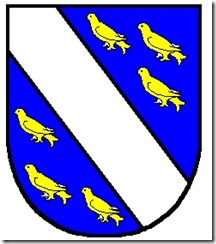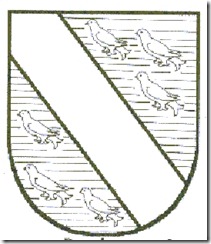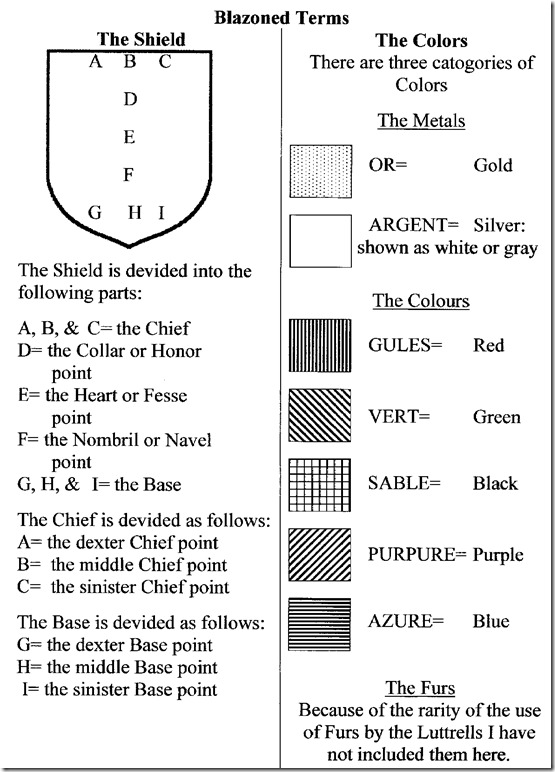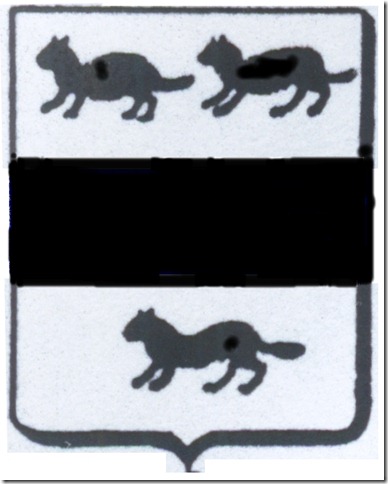Jessica Littrell posted the following on FaceBook in January of this year (2012):
 Jessica is the daughter of Rex Littrell, son of Noble.
Jessica is the daughter of Rex Littrell, son of Noble.
The Heralds:
by Glenn Littrell (in response to Jessica’s FaceBook post)
The coat of arms and the laws that protected them were administered by the heralds, who were in charge of verifying that a person had a right to a coat of arms, and once verified the heralds were tasked with recording the coat of arms. Whenever the ancient heralds recorded a coat of arms, they would use two methods: blazon and emblazon. Families would display the coat of arms either in its full color (artwork, clothing, flags, documents,with family mottoes and shields, etc.); blazoned (documents correspondents and with family mottoes, etc); emblazoned (woodwork, metalwork, glass ware and documents, etc.)
To “blazon":
To blazon, is to describe a coat of arms in a very exact worded method. Blazoning was usually in French or Latin. Because of the expense of ink and paper, it was more efficient to develop a coded system of describing a coat of arms in a manner so anyone could draw and paint the coat of arms strictly from the description. The herald would record the blazon in their records because it was more efficient than drawing the actual coat of arms. The necessity of blazoning (to save the cost of ink) is emphasized by the fact that it should normally contain no punctuation to avoid waste in the recording of the coat of arms. Besides the words that depicted a particular color, object, position, etc., the order of the words was very important. The system was very elaborate and too detailed to explain here, but some examples to understand better our ancestral coat of arms is provided.
The coat of arms displayed by Jessica (above) are those of the Dunster branch of the family and the blazon would be:
or a bend between six martlets sable
The shield is yellow or gold, the bend (the diagonal stripe) is between the martlets (the birds), and both the bend and six martlets are black.
To break down the blazoning for this Coat of Arms:
- or=gold
- a bend=is the the bar going from the top left to lower right of the shield (bend sinister would mean top right to bottom left and some cases indicated illegitimate birth). A fesse is a horizontal bar, usually across the middle of the shield.
- between six martlets=mythical birds (see below note1)
- sable=black.
In the blazon the appearance of color (or, azure, sable etc.) means everything between that color and the preceding color is that color. The first color listed is the shield color.
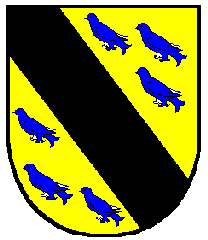
This coat of arms is from another branch of the family and is blazoned:
or a bend sable between 6 martlets azure
The shield is yellow or gold, the bend is black and between the martlets which are blue.
Looking only at the items contained within the shield, in this case the 'bend' and 'six martlets', those items are called the ‘elements’. Because the Coat of Arms is strictly drawn from the blazon the elements are the same in any depictions (blazon, emblazon, or drawing) of the Coat of Arms with some exceptions toward ‘style’.
The drawing of the shield will contain the same elements, and all elements will be in the same position in relation to the “area” of the shield.
But:
- the actual drawing of the martlets,
- their positioning within their area of the shield,
- and the shape of the shield…
can be different, showing certain “flair” and “style” of the artist. As can be seen by comparing the martlets on the shield at the top and the shield immediately above.
Also:
- The style of items outside of the shield (sometimes called supporters) might be banners, helmet, animals (swans, lions or boar), and/or crest,
- and even the shape of the shield…
are at the discretion of the artist, but, again, as always the elements and their position are identical as they are determined by the blazoning.
The artistic items outside the shield came along in a period when the rules for blazoning had started to be relaxed. The rules for items outside of the shield are not as strict as the rules for what is contained in, or upon, the shield and are seen by many a just extravagant elaborations. Nonetheless, they do tend to have some significant relevance to the person who added them. For instance at the top of the page what looks like a dog on the coat of arms (above the helmet) is an otter, which was placed there in reference to the Norman spelling and interpretation of the original name Loutre, ie., ‘the otter hunter’ (see below note2). Some branches of the family, and sometimes within the same line different generations, have replaced the otter with swans or boars.
note1:The Martlet was a mythical bird who spent its entire life in flight because it had no feet. It usually, but not always, indicates that the original bearer of
a coat of arms with Martlets on it was not born into nobility, they earned or obtain their station otherwise. In other words they were without a noble 'foundation'. No foundation, no feet... It is firmly believed that the original Luttrell in England was at the battle of Hastings, with William the Conqueror and earned his nobility there or soon after.
As explained above the artist could style the martlets with any flair he desired as long as they maintained the feature that distinguished them from other birds… no feet. If they possessed feet then he will have broken the rules of heraldry because they would now just be birds, not martlets.
note2:Our name has undergone many spellings and pronunciation. Here is the European progression, some of which carry over into Ireland, Australia, Canada and America:
Lotre~Loutre~Lelutre~Letre~Looterel~Loteral~Loterel~Loterell~Lotrel~Louterel~Loutrel~Loutterellus~Lutra~Lutre~Lutterell~Luttrell~Luttrull
To “emblazon”:
This method was to draw a black and white picture of the coat of arms.
Even in the case of being able to afford the price of ink the cost of colored ink might still prove to be unaffordable. Additionally on such items as glass, silver, wood, etc., the colors were not depicted in any way, as this was either impossible, or again too expensive. For these reasons they would show the colors by using different patterns, such as vertical or horizontal lines. Often the drawing of the coat of arms occurred from the blazoned description in the absence of an actual copy.
Whenever a coat of arms was drawn from an emblazon, just like when it was done from a blazon, the drawings of the same coat of arms may differ in style (of the artist) but not in content.
Below, the full color on the left, the emblazoned on the right, and the blazon below are all depictions of the same Coat of Arms (from a third branch of the family).
azure a bend argent between six martlets or
The shield on the left is:
- the shield is azure, which is blue
- the bend is argent which is silver
- and it is between the six martlets that are or, which is gold or yellow
The shield on the right is emblazoned, a black and white drawing of the coat of arms using patterns to represent color:
- horizontal lines represent the color of the shield azure, which is blue
- the blank (or white) bend represents the color of the bend argent, which is silver
- and the dotted martlets (not clearly showing up here) represents the color of six martlets or, which is gold or yellow
Using the above information how would you ‘blazon’ the following coat of arms:
Hint: the three (3) animals are also otters.
Use(click) the comment/no comment link below to enter your blazon or to ask questions.
by Glenn Littrell.
The first edition is no longer available, but I am working on the second edition and now that I’m retired I hope to complete it in 2013. Check back to this website periodically.


